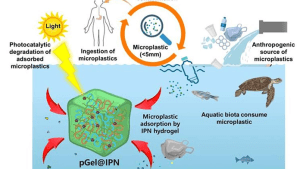TAG: GS 3: SCIENCE AND TECHNOLOGY
THE CONTEXT: Researchers at the Indian Institute of Science (IISc) have developed a novel hydrogel aimed at tackling the pervasive issue of microplastic pollution in water bodies.
EXPLANATION:
- Microplastics, posing significant threats to both human health and the environment, have become a pressing concern globally.
- In response, the IISc team has engineered a sustainable solution with promising capabilities.
Microplastic Threat
- Microplastics, tiny plastic particles, have emerged as a major environmental hazard, permeating various ecosystems and endangering aquatic and terrestrial lifeforms.
- With the ability to infiltrate drinking water sources, microplastics also pose health risks to humans.
- The urgency to address this challenge has prompted innovative research efforts.
Three-Layer Polymer Hydrogel
- The developed hydrogel features a sophisticated three-layer polymer structure, comprising chitosan, polyvinyl alcohol, and polyaniline.
- This unique intertwining of polymers forms an interpenetrating polymer network (IPN) architecture, enhancing the material’s efficacy in microplastic removal.
- Traditional filtering membranes, prone to clogging, are bypassed in favor of this resilient hydrogel.
- Infusing the hydrogel with nanoclusters of copper substitute polyoxometalate (Cu-POM) introduces catalytic capabilities.
- Under UV light irradiation, these nanoclusters facilitate the degradation of microplastics, rendering them less harmful.
- This synergistic combination of polymers and nanoclusters results in a robust hydrogel capable of both adsorbing and degrading microplastics.

This hydrogel could remove over 90% of microplastics
Tracking and Efficiency Assessment
- Addressing the challenge of microplastic detection, the researchers incorporated a fluorescent dye into the hydrogel.
- This enables the tracking of microplastic removal and degradation under various environmental conditions, including pH levels, temperatures, and microplastic concentrations.
- The hydrogel exhibits high efficiency, removing up to 95% of microplastics in near-neutral pH conditions.
Durability and Strength
- In addition to its efficacy, the hydrogel demonstrates durability and strength, crucial for practical applications.
- The combination of polymers ensures stability across diverse temperature ranges, enhancing the material’s resilience under different environmental conditions.
- This durability underscores the potential of the hydrogel as a sustainable solution for microplastic remediation.

